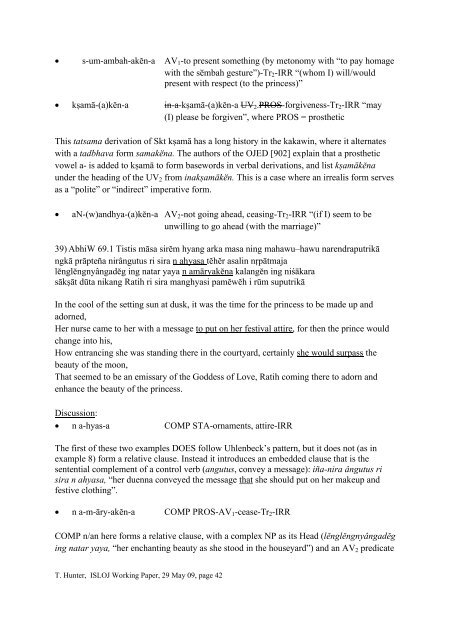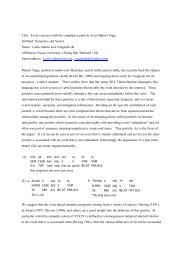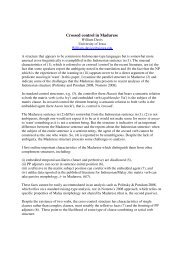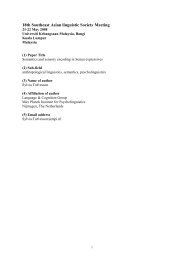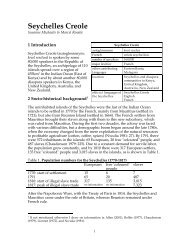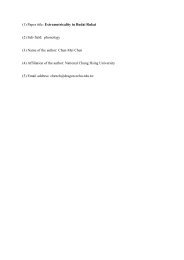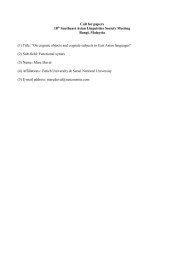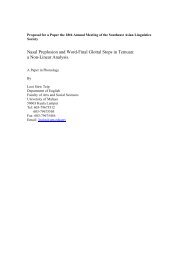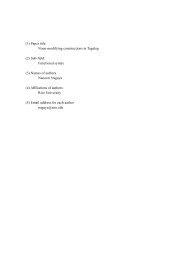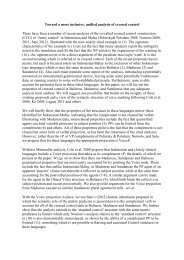Working Paper on Irrealis, Imperative Mode and Complementation ...
Working Paper on Irrealis, Imperative Mode and Complementation ...
Working Paper on Irrealis, Imperative Mode and Complementation ...
Create successful ePaper yourself
Turn your PDF publications into a flip-book with our unique Google optimized e-Paper software.
s-um-ambah-akĕn-a AV1-to present something (by met<strong>on</strong>omy with “to pay homage<br />
with the sӗmbah gesture”)-Tr2-IRR “(whom I) will/would<br />
present with respect (to the princess)”<br />
kṣamā-(a)kĕn-a in-a-kṣamā-(a)kĕn-a UV2-PROS-forgiveness-Tr2-IRR “may<br />
(I) please be forgiven”, where PROS = prosthetic<br />
This tatsama derivati<strong>on</strong> of Skt kṣamā has a l<strong>on</strong>g history in the kakawin, where it alternates<br />
with a tadbhava form samakӗna. The authors of the OJED [902] explain that a prosthetic<br />
vowel a- is added to kṣamā to form basewords in verbal derivati<strong>on</strong>s, <strong>and</strong> list kṣamākĕna<br />
under the heading of the UV2 from inakṣamākӗn. This is a case where an irrealis form serves<br />
as a “polite” or “indirect” imperative form.<br />
aN-(w)<strong>and</strong>hya-(a)kĕn-a AV2-not going ahead, ceasing-Tr2-IRR “(if I) seem to be<br />
unwilling to go ahead (with the marriage)”<br />
39) AbhiW 69.1 Tistis māsa sirĕm hyang arka masa ning mahawu‒hawu narendraputrikā<br />
ngkā prāpteña nirângutus ri sira n ahyasa tĕhĕr asalin nṛpātmaja<br />
lĕnglĕngnyângadĕg ing natar yaya n amāryakĕna kalangĕn ing niśākara<br />
sākṣāt dūta nikang Ratih ri sira manghyasi pamĕwĕh i rūm suputrikā<br />
In the cool of the setting sun at dusk, it was the time for the princess to be made up <strong>and</strong><br />
adorned,<br />
Her nurse came to her with a message to put <strong>on</strong> her festival attire, for then the prince would<br />
change into his,<br />
How entrancing she was st<strong>and</strong>ing there in the courtyard, certainly she would surpass the<br />
beauty of the mo<strong>on</strong>,<br />
That seemed to be an emissary of the Goddess of Love, Ratih coming there to adorn <strong>and</strong><br />
enhance the beauty of the princess.<br />
Discussi<strong>on</strong>:<br />
n a-hyas-a COMP STA-ornaments, attire-IRR<br />
The first of these two examples DOES follow Uhlenbeck’s pattern, but it does not (as in<br />
example 8) form a relative clause. Instead it introduces an embedded clause that is the<br />
sentential complement of a c<strong>on</strong>trol verb (angutus, c<strong>on</strong>vey a message): iña-nira ângutus ri<br />
sira n ahyasa, “her duenna c<strong>on</strong>veyed the message that she should put <strong>on</strong> her makeup <strong>and</strong><br />
festive clothing”.<br />
n a-m-āry-akĕn-a COMP PROS-AV1-cease-Tr2-IRR<br />
COMP n/an here forms a relative clause, with a complex NP as its Head (lĕnglĕngnyângadĕg<br />
ing natar yaya, “her enchanting beauty as she stood in the houseyard”) <strong>and</strong> an AV2 predicate<br />
T. Hunter, ISLOJ <str<strong>on</strong>g>Working</str<strong>on</strong>g> <str<strong>on</strong>g>Paper</str<strong>on</strong>g>, 29 May 09, page 42


